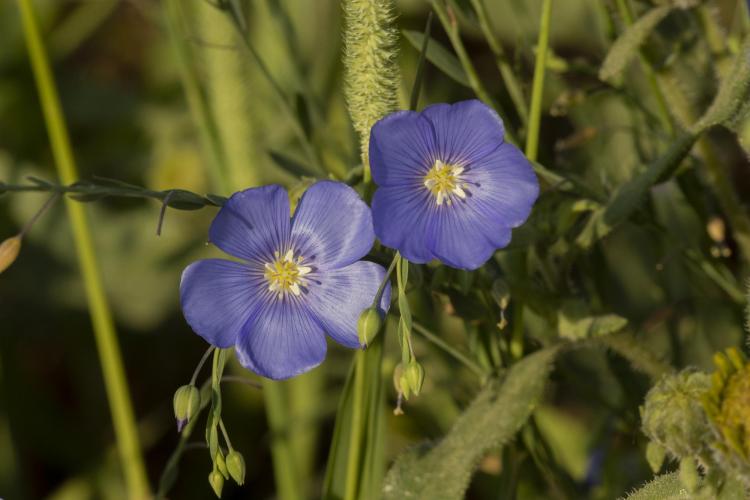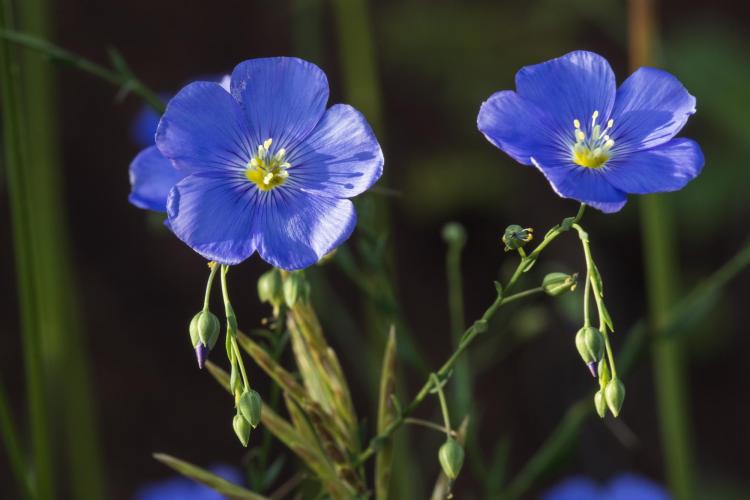Domestication of Lewis flax has begun
Understanding genetic diversity in a species is especially important for conservation and restoration efforts
Bright blooms of Lewis flax, Linum lewisii, are probably familiar to most people, for they are attractive, conspicuous and widespread. Lewis flax is native to North America, from Alaska to Texas and from California to the Midwest, with isolated populations in West Virginia. But our native Lewis flax is not the flax species most familiar to people around the world.
The flax we eat and make cloth from, Linum usitatissimum, is native to Europe and all areas around the Mediterranean Sea. Archeologists found evidence that people were collecting flax seeds more than 10,000 years ago in Tell Abu Hureyra, a site in the Euphrates Valley of Syria. Genetic data reveal that domestication began about 8,000 years ago, when the earliest lineage was selected for seed oil content. Subsequent domestication programs limited seed dispersal to make seed harvesting easier and also produced varieties with enhanced fiber content and cold tolerance.
Lewis flax is named L. lewisii to honor Meriwether Lewis, explorer, naturalist, and the leader of the Lewis and Clark expedition, commissioned by President Thomas Jefferson to explore the vast new land acquired by the Louisiana Purchase. Lewis collected the specimen of flax in 1806 in the Rocky Mountains.

Bright blossoms of Lewis flax are seen from the plains to tree line. Photo by Jeff Mitton.
Four species of flax are native to Colorado. Meadow flax, Linum pratense, is blue in color like Lewis flax but is annual, whereas Lewis flax is perennial. Two other native flax species have yellow flowers, very slender flower stalks, and much smaller geographic distributions centered on the Four Corners area. These are yellow bristle flax, Linum aristatum, and yellow hairy flax, Linum puberulum.
Peter Innes and Nolan Kane, graduate student and professor, respectively, in CU’s Department of Ecology and Evolutionary Biology, have initiated genomics research in blue flax. In collaboration with Dr. Brent Hulke’s lab at North Dakota State University, they are sequencing the entire genomes of plants from several environments to develop genetic markers and examine patterns of genetic variation. Flax’s broad geographic range encompasses an incredible diversity of habitats—in Colorado it grows from the plains to tree line—suggesting it may have high levels of genetic diversity.
Understanding genetic diversity in a species is especially important for conservation and restoration efforts. Innes is particularly interested in blue flax’s use to restore disturbed environments, and he described a need to understand the degree to which flax is adapted to different environments to better manage restoration efforts. While species-level genetic diversity may be high, individual flax populations may be genetically distinct from each other due to local adaptation. If flax is, indeed, adapted to its local environment, the Forest Service would want to use different sources of seed for restoration efforts in warm, dry low elevation sites versus cold, wet sites at high elevations.
Flax’s broad geographic range encompasses an incredible diversity of habitats,"
Innes and Kane also plan to determine the extent to which Lewis flax hybridizes with a similar, non-native species of perennial blue flax, Linum perenne. This species was introduced from Eurasia to North America by horticulturists, but it has escaped and is now likely widespread. Its similarity to native Lewis flax has led to its accidental use in several restoration efforts. The extent of hybridization between introduced and Lewis flax is unknown, but both grow locally, so we do not know whether local Lewis flax populations contain genes from hybridization, which should make them unsuitable for restoration purposes.
While Lewis flax is an important native species used in habitat restoration projects in Boulder and across the western U.S., it also shows promise as a more sustainable alternative to the existing European flax varieties. The oils of Lewis flax seeds are similar to oils in domesticated European flax, suggesting that Lewis flax could be used for food and oil extraction. The two species differ, however, in that domesticated European flax is annual, while Lewis flax is perennial, growing back multiple years in a row. Perennial crops require less input from farmers and also benefit agricultural ecosystems by stabilizing topsoil. New genetic markers would facilitate development of strains of Lewis flax for consumption of seeds, seed oil production and fiber production.
Domestication of the European flax started about 8,000 years ago and it took thousands of years to develop the varieties used for linseed oil versus those used for fiber to make fine linens. But these are different times, with deeper insights into plant genomes that change how we select for favorable traits. Modern genomic studies are able to determine which genes influence various traits and to generate thousands of genetic markers to be used in the selection programs. In contrast to the first domestication of flax, which occurred over millenia, this domestication event might produce the desired varieties in decades.

Bright blossoms of Lewis flax are seen from the plains to tree line. Photo by Jeff Mitton.

